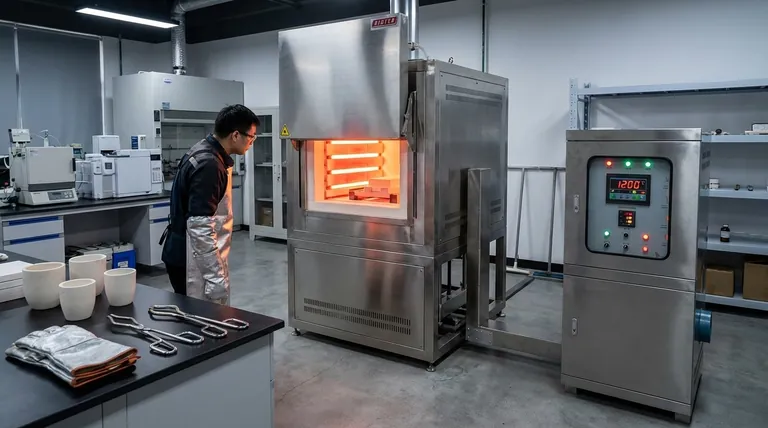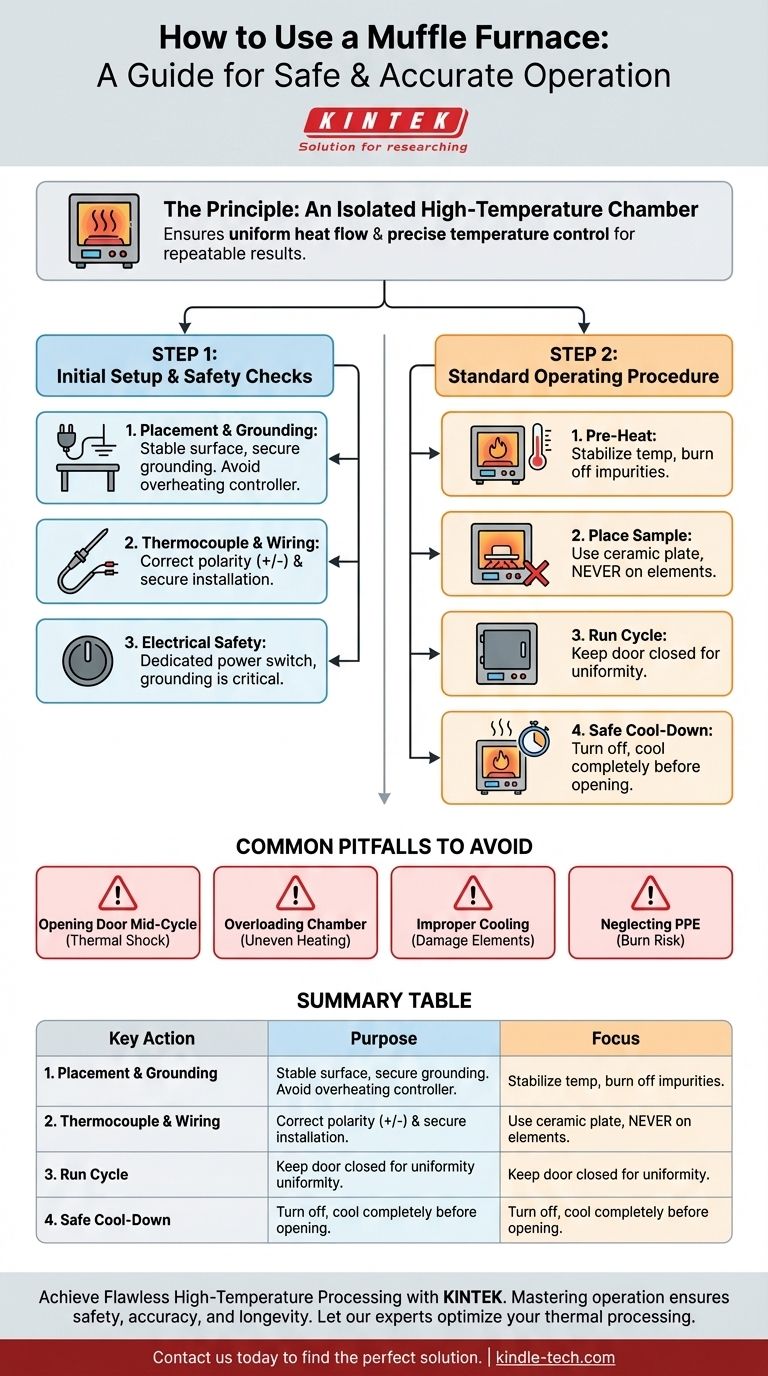To use a muffle furnace, you must first ensure it is properly set up and grounded on a stable surface. The core process involves turning on the power, setting the desired temperature, and allowing the furnace to pre-heat. Once stable, you place your sample inside the chamber, close the door, and run the heating cycle for the required time before turning off the power and letting the furnace cool completely before removing the sample.
The key to using a muffle furnace is understanding its purpose: to create a highly controlled and isolated thermal environment. Correct operation is not just about following steps, but about maintaining this control to ensure safety, achieve accurate results, and protect the equipment.

The Principle: An Isolated High-Temperature Chamber
How It Works
A muffle furnace uses electric heating elements to heat an insulated chamber to very high temperatures. The term "muffle" refers to the chamber's ability to isolate the material being heated from the heating elements and any contaminants from combustion (in fuel-fired models).
This design ensures uniform heat flow and precise temperature control, which are critical for repeatable scientific and industrial processes. The chamber is typically lined with high-quality refractory bricks or insulation to prevent heat loss and maintain efficiency.
Step 1: Initial Setup and Safety Checks
Physical Placement
Before operation, place the furnace on a flat, stable surface. Ensure the temperature controller is positioned away from the furnace body to prevent it from overheating, which can damage its sensitive electronics.
Thermocouple and Wiring
The thermocouple is the sensor that measures the internal temperature. Insert it into the furnace chamber through its designated port, filling any gaps with asbestos rope to prevent heat leakage. Connect it to the controller, paying close attention to the correct polarity (+ and -).
Electrical Safety
Always install a dedicated power switch at the main power line inlet for the furnace. Crucially, both the furnace and the controller must be securely grounded to prevent electrical shock. Only personnel authorized by management should operate the furnace.
Step 2: The Standard Operating Procedure
Pre-Heating and Conditioning
Turn on the power and set your target temperature. After the first use or long periods of inactivity, it is best practice to run the furnace empty for a period. This "baking" process helps stabilize the internal environment and burns off any residual impurities.
The furnace's indicator lights will show its status. Typically, a green light indicates the temperature is rising, while a red light signifies it has reached and is maintaining the set temperature.
Placing Your Sample
Wait for the furnace to reach and stabilize at the set temperature. Carefully place your samples into the chamber, ensuring they are stable and will not tip over during the process.
Never place samples directly on the heating elements or the furnace floor if it contains elements. This can cause severe damage and create a fire risk. Use a ceramic plate or appropriate crucible.
Running the Heating Cycle
Close the furnace door securely during heating. This is essential to prevent heat loss, maintain temperature uniformity, and stop cold air from entering, which could thermally shock your sample or the furnace chamber. Monitor the temperature throughout the process to ensure it remains stable.
Safe Shutdown and Cooling
After the required heating time has elapsed, turn off the furnace power. Do not open the door immediately. Allow the furnace to cool down naturally to a safe temperature before carefully removing your samples using appropriate heat-resistant gloves and tongs.
Common Pitfalls to Avoid
Opening the Door Mid-Cycle
Resist the urge to check on your sample by opening the door. The sudden influx of cold air can crack the furnace's insulation or your sample, a phenomenon known as thermal shock.
Overloading the Chamber
Placing too many samples in the furnace can obstruct airflow and lead to non-uniform heating. This compromises the accuracy and consistency of your results.
Improper Cooling
Forcing the furnace to cool too quickly can damage the internal refractory materials and heating elements, shortening the equipment's lifespan. Always allow for a slow, natural cool-down period.
Neglecting Safety Gear
The exterior of a furnace can remain extremely hot long after it has been turned off. Always assume it is hot and use appropriate personal protective equipment (PPE), including heat-resistant gloves and safety glasses.
Key Principles for Successful Operation
- If your primary focus is accuracy and repeatability: Always pre-heat the furnace and allow the temperature to stabilize before introducing your sample, ensuring consistent and uniform results every time.
- If your primary focus is operator and equipment safety: Never bypass safety features like grounding, and always allow the furnace to cool completely before removing your materials to prevent burns and thermal shock.
- If your primary focus is maximizing equipment lifespan: Avoid placing samples directly on heating elements and never introduce cold items into a hot furnace, as this prevents costly damage to core components.
By mastering these operational principles, you ensure not only the safety of your workspace but also the integrity and reliability of your results.
Summary Table:
| Step | Key Action | Purpose |
|---|---|---|
| 1. Setup | Ensure stable placement, secure grounding, and correct thermocouple installation. | Foundation for safety and accurate temperature control. |
| 2. Operation | Pre-heat to stabilize, place sample correctly, run cycle with door closed. | Achieve uniform heating and prevent thermal shock. |
| 3. Shutdown | Turn off power and allow furnace to cool completely before opening. | Protect samples, equipment, and ensure operator safety. |
Achieve Flawless High-Temperature Processing with KINTEK
Mastering muffle furnace operation is crucial for the integrity of your laboratory work. Whether you are conducting ashing, heat treatment, or material sintering, proper technique ensures safety, accuracy, and equipment longevity.
KINTEK specializes in providing reliable lab equipment and consumables tailored to your laboratory's specific needs. Our expertise ensures you have the right tools and support for successful, repeatable results.
Let our experts help you optimize your thermal processing. Contact us today via our form to discuss your application and find the perfect solution for your lab.
Visual Guide

Related Products
- Laboratory Muffle Oven Furnace Bottom Lifting Muffle Furnace
- 1800℃ Muffle Oven Furnace for Laboratory
- 1700℃ Muffle Oven Furnace for Laboratory
- 1400℃ Muffle Oven Furnace for Laboratory
- 1400℃ Laboratory Quartz Tube Furnace with Alumina Tube Tubular Furnace
People Also Ask
- What are the factors affecting the rate of melting process? Master Heat Transfer for Faster Results
- At what temperature is it safe to open a muffle furnace? A Guide to Preventing Injury and Equipment Damage
- What is the burnout cycle on a furnace? Stop This Destructive Overheating Pattern Now
- What affects the melting point of a substance? Uncover the Key Factors & Forces
- Does melting point ever change? Unlock the Secrets of Pressure and Purity



















